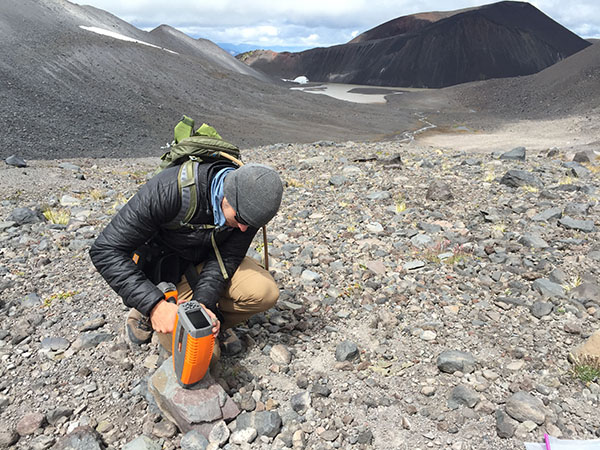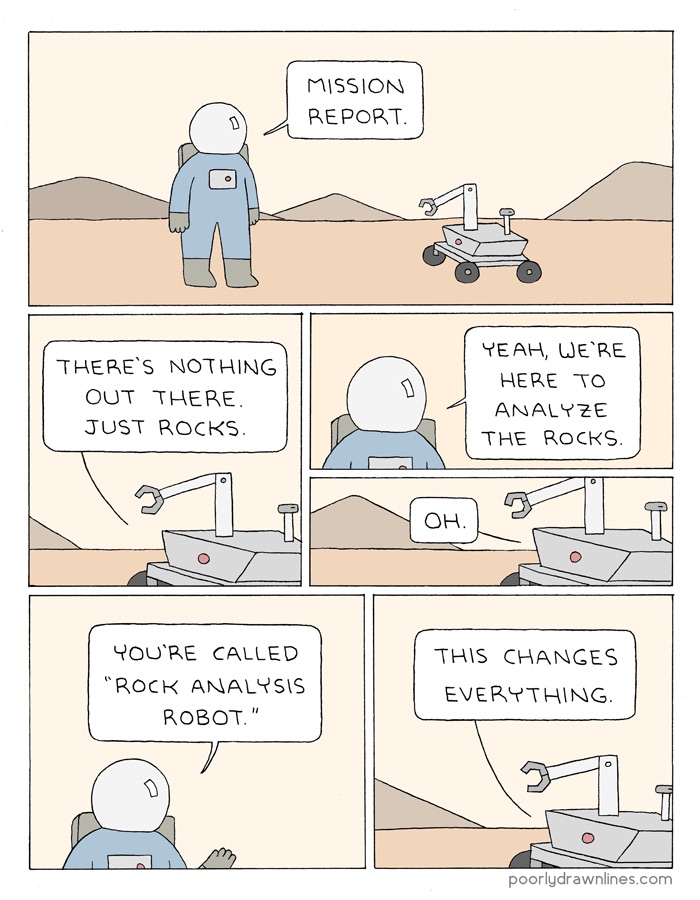Instrumentation
- New! Bruker Invenio-S FTIR + Harrick Praying Mantis Diffuse Reflectance Reaction Chamber, 0.9-30 microns bidirectional reflectance, Temperatures from ambient to 910 C under vacuum, Pressures from vacuum up to 15 bars
- ASD QualitySpec Trek - Highly portable field reflectance spectrometer, visible/near-infrared, 350-2500 nm, cm spot size, contact measurements only.
- ASD FieldSpecPro3 - Moderately portable field reflectance spectrometer, visible/near-infrared, 350-2500 nm, fiber optic input with multiple accessories, including 2-4 mm nadir reflectance.
- FLIR E75sc Advanced Thermal Infrared Camera - 320x240 resolution, acquires both thermal images and higher resolution visible images.

ASD Trek spectrometer in the wild, as wielded by PhD student Noel Scudder in the Collier glacial valley, OR.
Code - coming soon!
Ferrous parameters code
Data - coming soon!
- Horgan et al. (2014): Mafic mineral spectra, mixture spectra, band parameters
- TIR spectral libraries
- Ackiss et al. (2019) palagonite unmixing library (for lab spectra)
- McBride et al. (2019) tephra unmixing library (for lab spectra)
- Scudder et al. (2019) igneous unmixing library (for lab spectra)
- Coming soon:
- McBride et al. (2019) basaltic tephra VNIR/TIR spectra
- Scudder et al. (2019) volcanic suite VNIR/TIR spectra
Teaching
I believe that no one should reinvent the wheel with teaching, and am happy to share all teaching materials with other faculty. Please email me for more information.
Current and recent courses include:
- EAPS 556: Planetary Geology - Course intended to acquaint both planetary and non-planetary graduate students with the perse processes that shape and sculpt the surfaces of solid planetary bodies, from small asteroids and comets, to the inner solid planets like Earth, and to the satellites of gas giants like Jupiter. The course focuses on processes such as faulting, tectonics, volcanism, impact cratering, landslides, and weathering from wind, water, and ice. The class also includes two required one-day field trips to examine terrestrial analogs of planetary processes.
- EAPS 577: Remote Sensing of the Planets - Mixed undergraduate/graduate course that introduces students to key planetary and Earth science satellite remote sensing datasets, including visible and thermal imagery, visible through mid-infrared spectroscopy, radar, gamma ray and neutron spectroscopy, and laser altimetry. Students get hands-on experience with data acquisition, image processing in IDL, spectral analysis in ENVI and Davinci, crater counting, and geologic mapping in GIS programs.
- EAPS 590: Field Geology of North America - Week-long field course typically taught during spring break in collaboration with Prof. Ken Ridgway and other rotating EAPS faculty. The course aims to provide students with hands-on experience in field mapping, stratigraphy, surface processes, and ground truthing remote sensing data sets. Past locations include Death Valley, Arches/Canyonlands/Great Salt Lake, Big Bend, and Northern Arizona.
- EAPS 291: Research Methods in Planetary Science - A new course under development for undergraduate planetary science majors. This course will give sophomore students hands-on experience designing and implementing a research project, including basic computer skills, scientific programming, and statistical analysis, as applied to real problems in planetary science. This course is intended to prepare students for research experiences both within and outside of Purdue.
-
EAPS 105: The Planets - Introductory course for majors and non-majors. This course deals with the physical, chemical, and geological nature of the planets. We learn how we arrived at our current state of knowledge through the history of astronomy and the modern exploration of space. Similarities and differences between the Earth and other planets are described and discussed, placing our Earth in context with our general understanding of planets both inside and outside the solar system.
Memes we love



